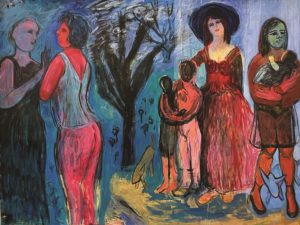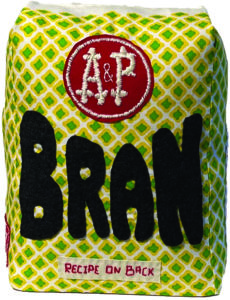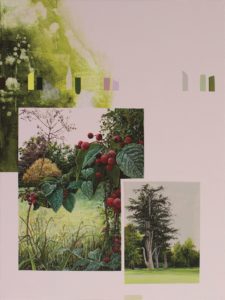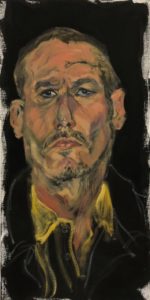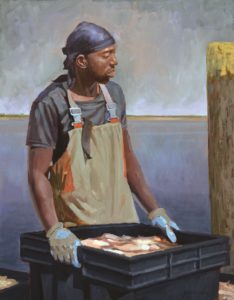Over the past several months, Diane Messinger has been attending live broadcasts of performances from the Metropolitan Opera at Wellfleet Harbor Actors Theater (WHAT). This month, her fellow opera fans will also have the opportunity to view Messinger’s multi-figure paintings in The Gallery at WHAT. These loose and colorful works resonate with some of the most salient qualities of opera: narrative, human interaction, and drama.
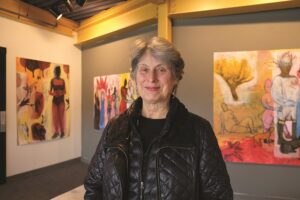
In one large painting, A Girl With Long Nose, figures stand together in the foreground. A couple at the center commands the narrative: a woman in a blue dress places her hand on the chest of a man wearing a white gown, calf-length boots, and a winged mask. She looks at him imploringly while a group of women and girls turn their heads toward the couple, observing the interaction with a hushed curiosity. Among them is the figure for whom the painting is titled. She cradles a baby and looks back at the couple while headed in her own direction, toward a different destiny. Yet another woman — nude, and more drawn than painted — lounges on the grass unconcerned with the entire situation.
“I like relationships or some kind of interaction going on,” says Messinger. “That’s what I like about opera. You can have all these things going on on the stage. It’s all different, and it’s all related.” Messinger’s painting is opera-like in that it has a central dramatic element that is enriched by characters and smaller narratives that together create something that feels complex and layered. (It’s a dynamic that Messinger says she also sees in crowds of people she observes in public.)
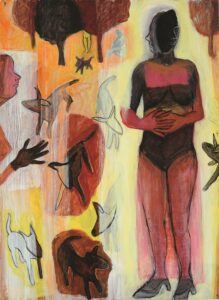
Messinger also looks to Renaissance painting for inspiration. “I love classical artwork and looking at work from the Renaissance with all those figures doing things,” she says. “They’re so beautiful.” Like the figures in many paintings of that period, most of Messinger’s figures inhabit a shallow space at the bottom of the composition, appearing like performers on a stage. In Barking, the space is deeper: the foreground and background contain two different narratives, linked by a group of small dogs cascading between them. People linger under a group of trees in the background. A woman breastfeeding a child is a quotation from Giorgione’s The Tempest, an early 16th-century Venetian painting famous for its ambiguous narrative and resistance to any definitive interpretation. Likewise, Messinger embraces ambiguity in her own work.
“Your guess is better than mine,” responds Messinger when asked about the meaning of the narratives in her work. She doesn’t begin to compose her paintings with a particular story in mind: “I know there’s a story, but it’s inside me,” she says. “I hope it reveals something about myself.”
Both the imagery and construction of the paintings capture an open-ended process. Hovering between painting and drawing, the pictures exist in a fluid state. Some figures are left as outlines; others are even more incompletely rendered. “If the figure doesn’t need an arm, I just take the arm off,” says Messinger.

Painting in acrylic on paper also provides her with a certain freedom. “If I want to add to a piece, I just glue on more paper,” she says. As a result, the paintings are as dynamic as their potential meanings.
For all the narrative ambiguity in her work, however, Messinger identifies themes in her paintings that relate to her own life and experience — feelings of anxiety and nervousness (“a response to so much pain in the world,” she says), as well as empathy and love. These themes are evident in two of the smaller works in the exhibition. In Red Dog, a figure dressed in a black abaya stands with her hand against the edge of the painting, as if it is holding her up. Other women turn toward her with concern. In other paintings, like Best Embrace, there are references to romantic love. Figures of women cradling infants also recur in her paintings, though the origin of the motif isn’t clear. A friend asked Messinger if it was because she didn’t have children. “I’m not sure,” she says. “I’m in my mid 70s. A lot has gone on in my life, and it’s all in the paintings. It’s all coming out.”
Born on the outskirts of Philadelphia, Messinger remained there for much of her life. She studied at the Pennsylvania Academy of Fine Arts, an institution known for its focus on the figure. “The Academy was great,” says Messinger. “It gave me such a foundation.” But she left the school without a degree: “It was the ’60s,” she says. “Things were crazy, and none of us looked to the future. We just looked to the immediate.”
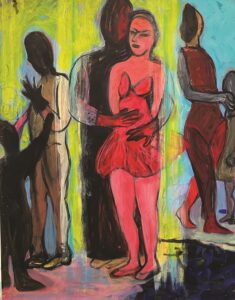
She participated in political protests while continuing to paint and worked as a waitress before returning to school in her 40s to finish her degree at the Tyler School of Art at Temple University. While she planned to start teaching after her studies, she found it wasn’t for her and continued to support herself through working in the service industry and as a decorative painter.
Truro had been a constant in her life. Her grandparents started visiting in the 1920s, and she came every August for many years, moving there in 2005. “I always wanted to live here,” she says. “I met my husband on the beach in Truro, and the rest is history.”
Since moving to the Outer Cape, Messinger says she has hit her stride creatively. The skills she has learned and the narrative threads of her life are building toward a kind of climax.
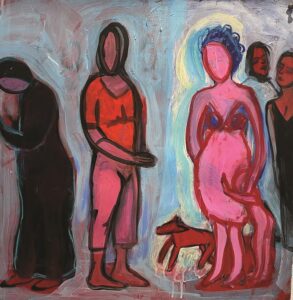
“I feel everything I’ve learned is in the paintings,” she says. “It’s nice to have all this experience to draw from. When I was younger, I was fearful or intimidated, and I couldn’t push myself in the art world. But I don’t think about those things now. I don’t care what anyone thinks. I go into my studio. That’s my sacred place. Life is still exciting, and there’s so much to do.”
A World of Her Own
The event: A show of paintings by Diane Messinger
The time: On view through April 29; open before scheduled events, during regular box office hours, and by appointment
The place: The Gallery at WHAT, 2357 Rt. 6, Wellfleet
The cost: Free; see what.org for information
